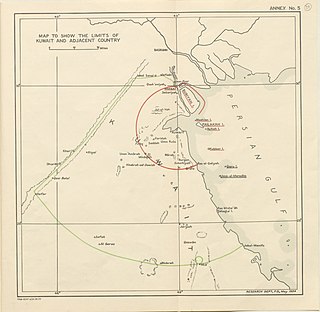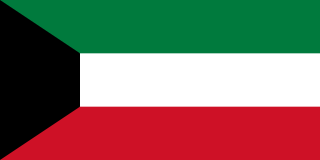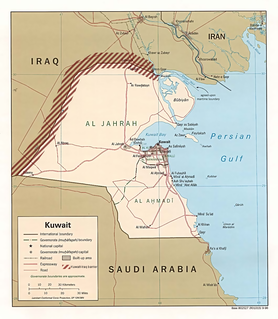 W
WThe Anglo-Ottoman Convention of 1913 was an agreement between the Sublime Porte of the Ottoman Empire and the Government of the United Kingdom which defined the limits of Ottoman jurisdiction in the area of the Persian Gulf with respect to Kuwait, Qatar, Bahrain, and the Shatt al-‘Arab. Signed, but never ratified, the long-lasting impact of the agreement was that of the status of Kuwait; the basis for both formal independence and the frontiers of modern Kuwait were established.
 W
WThe Basra Vilayet was a first-level administrative division (vilayet) of the Ottoman Empire. It historically covered an area stretching from Nasiriyah and Amarah in the north to Kuwait in the south. To the south and the west, there was theoretically no border at all, yet no areas beyond Qatar in the south and the Najd Sanjak in the west were later on included in the administrative system.
 W
WThe Battle of Jahra was a battle during the Kuwait–Najd War fought between Kuwaiti forces and Saudi-supported militants. The battle took place in Al-Jahra, west of Kuwait City on 10 October 1920 around the Kuwait Red Fort.
 W
WThe Battle of Sallasil or the Battle of Chains was the first battle fought between the Rashidun Caliphate and the Sasanian Persian Empire. The battle was fought in Kuwait (Kazima) soon after the Ridda Wars were over and Eastern Arabia was united under the authority of Caliph Abu Bakr. It was also the first battle of the Rashidun Caliphate in which the Muslim army sought to extend its frontiers.
 W
WLieutenant Colonel Harold Richard Patrick Dickson was a British colonial administrator in the Middle East from the 1920s until the 1940s, and author of several books on Kuwait.
 W
WDilmun, or Telmun, was an ancient Semitic-speaking polity in Arabia mentioned from the 3rd millennium BC onwards. Based on textual evidence, it was located in the Persian Gulf, on a trade route between Mesopotamia and the Indus Valley Civilisation, close to the sea and to artesian springs. A number of scholars have suggested that Dilmun originally designated the eastern province of Saudi Arabia, notably linked with the major Dilmunite settlements of Umm an-Nussi and Umm ar-Ramadh in the interior and Tarout on the coast. Dilmun encompassed Bahrain, Kuwait, Qatar and the eastern portion regions of Saudi Arabia. This area is certainly what is meant by references to "Dilmun" among the lands conquered by King Sargon of Akkad and his descendants.
 W
WHyspaosines was an Iranian prince, and the founder of Characene, a kingdom situated in southern Mesopotamia. He was originally a Seleucid satrap installed by king Antiochus IV Epiphanes, but declared independence in 141 BC after collapse of Seleucid authority in Iran and Babylonia to the Parthians. Hyspaosines briefly occupied the Parthian city of Babylon in 127 BC, where he is recorded in records as king (šarru). In 124 BC, however, he was forced to acknowledge Parthian suzerainty. He died in the same year, and was succeeded by his juvenile son Apodakos.
 W
WThe invasion of Kuwait on 2 August 1990 was a two-day operation conducted by Iraq against the neighboring State of Kuwait, which resulted in the seven-month-long Iraqi occupation of the country. This invasion and Iraq's subsequent refusal to withdraw from Kuwait by a deadline mandated by the United Nations led to military intervention by a United Nations-authorized coalition of forces led by the United States. These events came to be known as the first Gulf War and resulted in the expulsion of Iraqi forces from Kuwait and the Iraqis setting 600 Kuwaiti oil wells on fire during their retreat.
 W
WThe history of the Jews in Kuwait is connected to the history of the Jews in Iraq.
 W
WThe Kassites were people of the ancient Near East, who controlled Babylonia after the fall of the Old Babylonian Empire c. 1595 BC and until c. 1155 BC. The endonym of the Kassites was probably Galzu, although they have also been referred to by the names Kaššu, Kassi, Kasi or Kashi.
 W
WThe Neo-Babylonian Empire, also known as the Second Babylonian Empire and historically known as the Chaldean Empire, was the last of the Mesopotamian empires to be ruled by monarchs native to Mesopotamia. Beginning with Nabopolassar's coronation as King of Babylon in 626 BC and being firmly established through the fall of the Neo-Assyrian Empire in 612 BC, the Neo-Babylonian Empire would be short-lived, being conquered after less than a century by the Persian Achaemenid Empire in 539 BC.
 W
WOperation Vantage was a British military operation in 1961 to support the newly independent state of Kuwait against territorial claims by its neighbour, Iraq. The UK reacted to a call for protection from Sheikh Abdullah III Al-Salim Al-Sabah of Kuwait, and air, sea and land forces were in place within days. Iraq did not attack and the British forces were replaced by the Arab League. Iraq recognised Kuwaiti independence in 1963.
 W
WThe Persian Gulf Residency was an official colonial subdivision of the British Raj from 1763 until 1947, whereby the United Kingdom maintained varying degrees of political and economic control over several states in the Persian Gulf, including what is today known as the United Arab Emirates and at various times southern portions of Persia, Bahrain, Kuwait, Oman, and Qatar.
 W
WThis is a survey of the postage stamps and postal history of Kuwait.
 W
WQahtān to distinguish between the tribe and the Qahtanite peoples, is an Arab tribal confederation. Qahtan is composed of three main tribes: Sanhan, Junb, and Rufaida. Today, members of the tribe and its sub-tribes are based in Yemen, Saudi Arabia, Kuwait, Qatar, Bahrain and the United Arab Emirates. The Madh'hiji Qahtan tribe is different from the Qahtanite peoples, because while all members of the Qahtan identify as Qahtanite through their ancestry to Qahtan son of Hud which the tribe is named after, not all Qahtanite tribes trace their ancestry back to the modern tribe known as Qahtan.
 W
WThe Republic of Kuwait was a short-lived and self-styled republic formed in the aftermath of the invasion of Kuwait by Ba'athist Iraq during the early stages of the Gulf War. During the invasion, the Iraqi Revolutionary Command Council stated that it had sent troops into the State of Kuwait to assist an internal coup d'état initiated by "Kuwaiti revolutionaries." A Provisional Government of Free Kuwait was set up on 4 August by the Iraqi authorities under the leadership of nine allegedly-Kuwaiti military officers led by Alaa Hussein Ali, who was given the posts of prime minister, commander-in-chief, minister of defense and minister of the interior.
 W
WThe Saudi Arabian–Kuwaiti neutral zone, also known as the Divided Zone, was an area of 5,770 km2 (2,230 sq mi) between the borders of Saudi Arabia and Kuwait that was left undefined when the border was established by the Uqair Convention of 2 December 1922.
 W
WThe Sheikhdom of Kuwait was a sheikhdom which gained independence from the Khalidi Emirate of Al Hasa under Sabah I bin Jaber in the year 1752. The Sheikhdom became a British protectorate between 1899 and 1961 after the Anglo-Kuwaiti agreement of 1899 was signed between Sheikh Mubarak Al-Sabah and the British government in India due to threats to Kuwait's independence from the Ottoman Empire.
 W
WThe Souk Al-Manakh stock market crash was the 1982 stock market crash of Kuwait's unofficial stock market, the Souk Al-Manakh. The Al-Manakh market was housed in an air-conditioned parking garage, and specialized in highly speculative and unregulated non-Kuwaiti companies. At its peak, its market capitalization was the third highest in the world, behind only the U.S. and Japan, and ahead of the U.K. and France.
 W
WUnited Nations Security Council Resolution 678, adopted on 29 November 1990, after reaffirming resolutions 660, 661, 662, 664, 665, 666, 667, 669, 670, 674 and 677, the Council noted that despite all the United Nations efforts, Iraq continued to defy the Security Council.
 W
WUnited Nations Security Council resolution 686, adopted on 2 March 1991, after reaffirming resolutions 660, 661, 662, 664, 665, 666, 667, 669, 670, 674, 677 and 678, the Council noted the suspension of military activities against Iraq and that all twelve resolutions continue to have full force and effect.
 W
WUnited Nations Security Council Resolution 687, adopted on 3 April 1991, after reaffirming resolutions 660, 661, 662, 664, 665, 666, 667, 669, 670, 674, 677, 678 and 686 (1991), the Council set the terms, in a comprehensive resolution, with which Iraq was to comply after losing the Gulf War. Resolution 687 was passed by 12 votes to one against (Cuba) with two abstentions from Ecuador and Yemen after a very extended meeting. Iraq accepted the provisions of the resolution on 6 April 1991.
 W
WUnited Nations Security Council Resolution 688, adopted on 5 April 1991, after receiving letters from the representatives of France, Iran, and Turkey and expressing its concern over political repression of the Iraqi people, including those in Iraqi Kurdistan, the Council condemned the repression and demanded that Iraq, as a contribution to removing the threat to international peace and security, end the repression and respect the human rights of its population.
 W
WUnited Nations Security Council resolution 689, adopted unanimously on 9 April 1991, after recalling Resolution 687 (1991), the Council noted a report by the Secretary-General and decided to establish the United Nations Iraq–Kuwait Observation Mission to monitor the demilitarized zone between Iraq and Kuwait, known as the Kuwait–Iraq barrier.
 W
WUnited Nations Security Council resolution 692, adopted on 20 May 1991, after recalling resolutions 674 (1990), 686 (1991) and 687 (1991), as well as taking the report by the Secretary-General, the Council decided to establish the United Nations Compensation Commission to deal with compensation claims resulting from Iraq's invasion of Kuwait, which subsequently led to the Gulf War.
 W
WThe Uqair Protocol or Uqair Convention was an agreement at Uqair on 2 December 1922 which defined the boundaries between Mandatory Iraq and the Sultanate of Nejd and Sheikhdom of Kuwait between Kuwait and Nejd. It was imposed by Percy Cox, the British High Commissioner to Iraq, in response to Bedouin raiders from Nejd under ibn Saud. Cox met ibn Saud and Major John More, the British Political Agent to Kuwait. The boundaries included a Saudi–Iraqi neutral zone and a Saudi–Kuwaiti neutral zone.